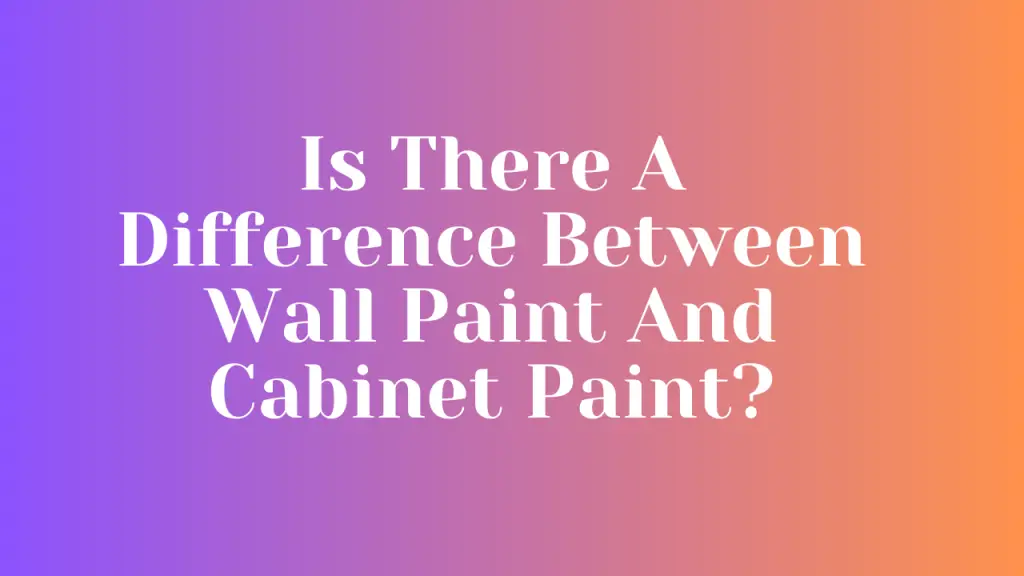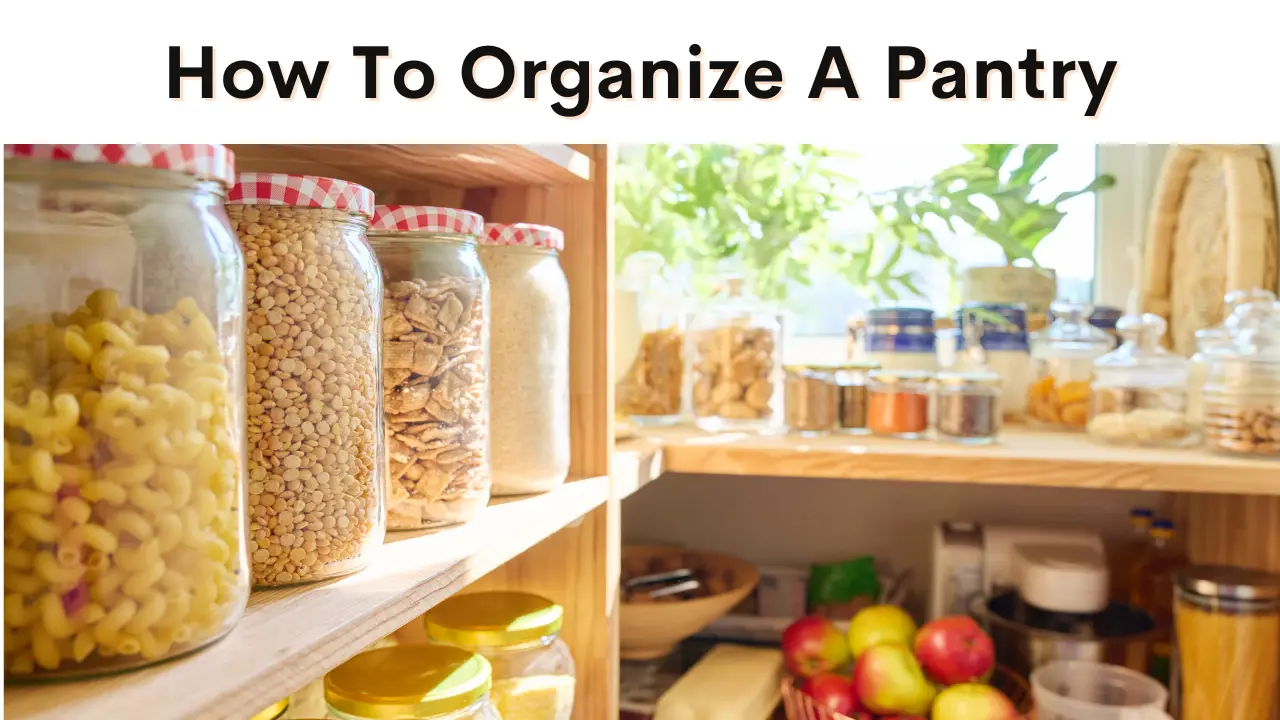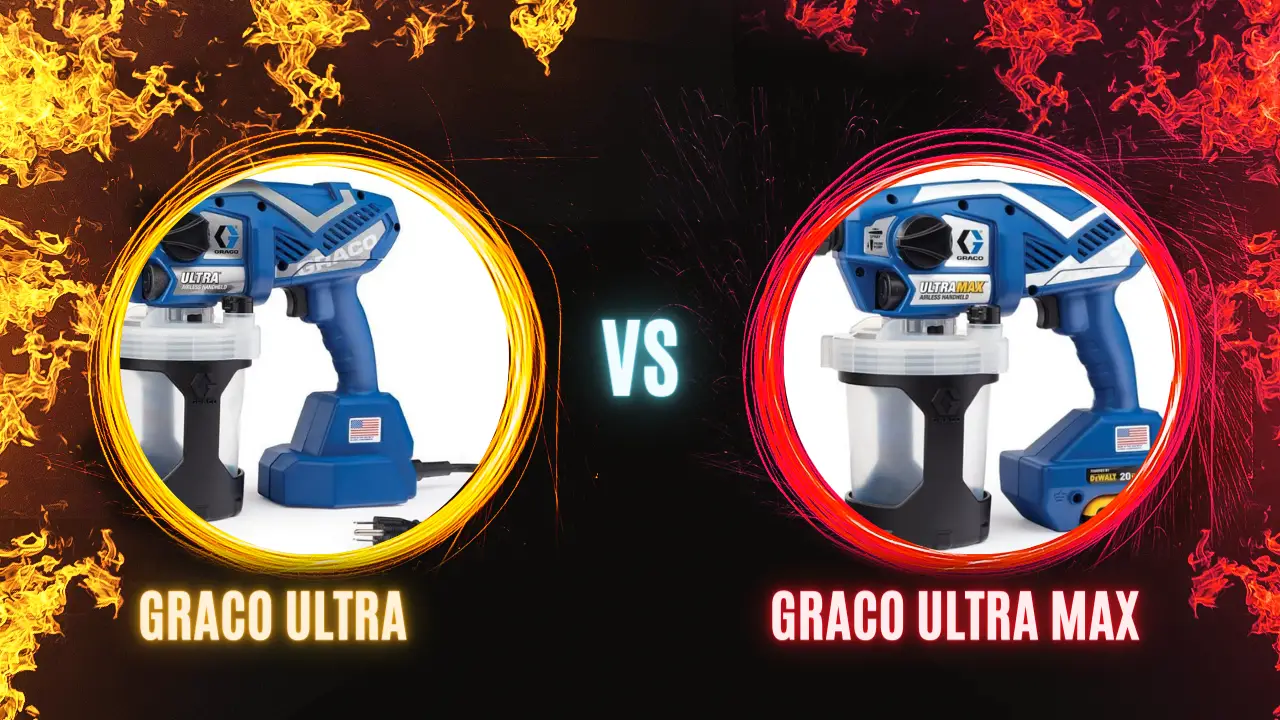Are you in the process of painting your home and wondering if there is a difference between wall paint and cabinet paint? Well, you’ve come to the right place!
In this article, we will delve into the nuances of these two types of paint and help you understand which one is best suited for each purpose. So, is there a Difference between wall paint and cabinet paint?
When it comes to wall paint, its primary purpose is to provide a fresh and appealing look to your walls while also protecting them from wear and tear. On the other hand, cabinet paint is specifically formulated to withstand the unique demands of kitchen and bathroom cabinets.
These areas are often exposed to moisture, heat, and constant use, which means that cabinet paint needs to be more durable and resistant to chipping, peeling, and yellowing over time.
Wall paint is typically designed to be more forgiving, as it needs to cover larger surface areas and withstand frequent cleaning.
So, as you can see, there is indeed a difference between wall paint and cabinet paint, and understanding these distinctions will help you make the right choice for your painting project.
Understanding the Purpose of Wall Paint and Cabinet Paint
Did you know that there’s a significant difference between wall paint and cabinet paint, and understanding their purpose can make all the difference in your home renovation project?
When it comes to choosing the right paint finish for cabinets, you need to consider durability and ease of cleaning. Cabinet paint is specially formulated to withstand the wear and tear of daily use, making it more resistant to chipping, fading, and staining compared to wall paint. It also has a smoother finish, allowing for easier cleaning and maintenance.
So, if you want your cabinets to look pristine and last for years, it’s crucial to use the right type of paint.
Proper preparation techniques for cabinet painting are essential for achieving a professional-looking result. Unlike walls, cabinets are often exposed to greasy fingerprints, food splatters, and moisture, which can affect the adhesion of paint. Therefore, it’s crucial to thoroughly clean and degrease the cabinet surfaces before painting.
This will ensure that the paint adheres properly and provides a smooth, long-lasting finish. Additionally, sanding the cabinets before painting can help create a better surface for the paint to adhere to, resulting in a more professional-looking finish.
By following these proper preparation techniques, you can ensure that your cabinet paint job not only looks great but also stands the test of time.
Choosing the Right Paint for Walls
When selecting the perfect paint for your walls, envision a color that will effortlessly transform your space.
Paint color selection is an important aspect of any interior design project. To choose the right paint for your walls, consider the overall aesthetic you want to achieve.
If you desire a calming and soothing atmosphere, opt for cool colors like blues and greens. On the other hand, if you want to create a vibrant and energetic space, warmer colors like yellows and oranges are a great choice.
It’s also essential to take into account the natural light in the room, as it can affect how the paint color appears. If the room receives plenty of natural light, you can play with bolder and darker shades, while in rooms with limited natural light, lighter colors can help brighten up the space.
When it comes to tips for painting walls, preparation is key. Start by cleaning the walls and repairing any cracks or imperfections. Use a primer to create a smooth surface and enhance the adhesion of the paint.
Don’t forget to protect your furniture and floors by covering them with drop cloths or plastic sheets. Before applying the paint, it’s advisable to cut in the edges with a brush and then use a roller for the larger areas. This technique ensures a neat and even finish.
Remember to allow sufficient drying time between coats and consider applying a second coat for a more opaque and durable result. With these tips in mind, you can confidently select the perfect paint color and achieve a beautiful and refreshed look for your walls.
Selecting the Best Paint for Cabinets
When selecting the best paint for cabinets, it’s important to consider durability and resistance to moisture and heat. Cabinets endure a lot of wear and tear, so choosing paint that can withstand these elements is crucial.
Additionally, different finishes can have a significant impact on the appearance of cabinets, so it’s worth exploring the various options available to achieve the desired look for your space.
Importance of durability and resistance to moisture and heat
The paint for cabinets needs to be highly durable and resistant to moisture and heat to withstand the daily wear and tear of a busy kitchen. When it comes to durability factors, cabinet paint should be able to withstand frequent cleaning and scrubbing without chipping or peeling. This is important because cabinets are constantly exposed to spills, splatters, and fingerprints, and durable paint will ensure that they can be easily cleaned without causing any damage.
Additionally, cabinet paint should have excellent adhesion properties, meaning it should stick well to the surface of the cabinets and not peel or chip off easily.
In terms of moisture resistance, cabinet paint needs to be able to withstand the high humidity levels often found in kitchens. Moisture can cause the paint to bubble, blister, or peel, which can significantly reduce the lifespan of the cabinets. Therefore, it is crucial to choose a paint that has moisture-resistant properties to protect the cabinets from the damaging effects of prolonged exposure to moisture.
Moreover, cabinet paint should also be heat-resistant to prevent any discoloration or warping that can occur when cabinets are exposed to heat from cooking appliances.
To summarize, when selecting paint for cabinets, it is essential to prioritize durability and resistance to moisture and heat. Here are a few factors to consider:
- Durability: Look for paint that can withstand frequent cleaning and scrubbing without chipping or peeling.
- Adhesion: Ensure that the paint has excellent adhesion properties and sticks well to the surface of the cabinets.
- Moisture Resistance: Choose a paint that is resistant to moisture to protect the cabinets from damage caused by high humidity levels.
- Heat Resistance: Opt for heat-resistant paint to prevent discoloration or warping when exposed to cooking appliances.
By considering these factors, you can ensure that the paint for your cabinets is long-lasting and can withstand the demands of a busy kitchen.
Different finishes and their effects on the appearance of cabinets
Choose the right finish for your cabinets and watch as they transform into stunning focal points that’ll leave you in awe.
When it comes to different finishes for cabinets, there are various options available that can have a significant impact on the overall appearance of your space. The finish you choose can completely change the aesthetic of your cabinets, giving them a sleek and modern look or a more traditional and rustic feel.
One popular finish for cabinets is a high-gloss finish. This finish creates a shiny and reflective surface that can make your cabinets appear more luxurious and modern. The high-gloss finish is also highly durable and easy to clean, making it a great choice for areas that receive a lot of use, such as kitchens or bathrooms.
On the other hand, if you prefer a more natural and understated look, a matte finish might be the way to go. This finish has a low sheen and can give your cabinets a soft and muted appearance. Matte finishes are great for creating a more relaxed and casual atmosphere in your space.
The choice of finish for your cabinets can have a significant impact on the overall look and feel of your space. Whether you opt for a high-gloss finish for a more modern and luxurious vibe or a matte finish for a softer and more understated aesthetic, each finish has its own unique charm.
Consider the style and atmosphere you want to create in your space and choose the finish that best suits your needs. With the right finish, your cabinets can become stunning focal points that’ll enhance the beauty of your entire room.
Proper Preparation and Application Techniques
To achieve a flawless finish, it’s essential to properly prepare and apply both wall paint and cabinet paint. When it comes to surface preparation, both types of paint require similar steps. You need to clean the surface thoroughly, remove any dirt or grease, and sand it lightly to create a smooth and even base. However, cabinet paint may require additional preparation, such as removing old varnish or paint layers, filling any cracks or holes, and priming the surface before applying the paint.
When it comes to paint application techniques, there are some differences between wall paint and cabinet paint. Wall paint is typically applied using a roller or a brush, while cabinet paint is often applied with a sprayer for a smoother and more professional finish. Additionally, cabinet paint may require multiple coats to achieve the desired color and coverage, while wall paint usually only requires one or two coats.
To summarize the differences between surface preparation and paint application techniques for wall paint and cabinet paint, refer to the table below:
| Aspect | Wall Paint | Cabinet Paint |
|---|---|---|
| Surface Preparation | Clean the surface, patch any holes or cracks, and prime if necessary. | Clean the surface, sand, and fill any imperfections. Prime if needed for better adhesion. |
| Material | Typically applied on drywall, plaster, or similar surfaces. | Applied on various materials like wood, MDF, or laminate. |
| Sanding | Light sanding may be required to smooth the surface. | Thorough sanding is crucial for a smooth and even finish. |
| Primer | Often requires a primer for better adhesion and uniform coverage. | Primer is essential for improved adhesion and a professional look. |
| Paint Application | Rollers and brushes are commonly used for large areas, with brushes for edges and corners. | Spray application is often used for a more even and fine finish. Brushes and rollers for touch-ups |
| Number of Coats | Typically 2 coats are applied for a solid color and even finish. Additional coats may be required for bold or dark colors. | Multiple coats (3 or more) are often needed for durability and depth of color. |
| Drying Time | Shorter drying time compared to cabinet paint. | Longer drying time, especially for oil-based paints. |
| Finish | Matte, eggshell, or satin finishes are common. | Satin, semi-gloss, or gloss finishes are popular. |
By following proper surface preparation techniques and using the appropriate paint application methods, you can ensure that both wall paint and cabinet paint will result in a beautiful and long-lasting finish.
Maintaining and Caring for Painted Walls and Cabinets
When it comes to maintaining and caring for your painted walls and cabinets, there are a few key points to keep in mind.
First, it’s important to follow proper cleaning and maintenance recommendations to keep your surfaces looking their best. This includes using gentle cleaning products and techniques that won’t damage the paint.
Second, you may need to touch up or repaint certain areas over time as wear and tear occurs. It’s a good idea to keep extra paint on hand for these touch-ups and to ensure a seamless finish.
Cleaning and maintenance recommendations
Keep your cabinets looking fresh and beautiful by regularly cleaning and maintaining them according to these expert tips.
To ensure the longevity of your cabinets, it’s important to use the right cleaning techniques. Here are some recommendations to keep in mind:
- Use a gentle cleaner: Avoid harsh chemicals or abrasive cleaners that can damage the paint or finish of your cabinets. Opt for a mild soap or detergent mixed with warm water instead.
- Wipe down regularly: Regularly wipe down your cabinets with a soft, damp cloth to remove any dust or dirt that may accumulate. This will help prevent grime from building up and potentially causing damage.
- Avoid excessive moisture: Excessive moisture can be detrimental to the paint or finish of your cabinets. Be cautious when cleaning near sinks or areas prone to water splashes. Dry up any spills or moisture immediately to prevent long-term damage.
- Handle with care: When cleaning or maintaining your cabinets, be gentle with the surfaces. Avoid using abrasive scrubbers or rough materials that can scratch or chip the paint. Treat your cabinets with care to ensure their longevity.
By following these cleaning and maintenance recommendations, you can keep your cabinets in pristine condition and prevent any unnecessary damage. Regular care and attention will help preserve the beauty of your cabinets for years to come.
Touching up and repainting as needed
You can easily refresh the look of your cabinets by touching them up or repainting them as needed. Over time, cabinets can become worn or chipped, but with the right techniques, you can make them look brand new again. When it comes to touching up, there are a few techniques you can use. First, start by cleaning the surface of the cabinets to remove any dirt or grime. Then, lightly sand the area that needs touch-up to create a smooth surface. After that, apply a primer to ensure that the new paint adheres properly.
Finally, match the color of the existing paint and carefully apply it to the area. By using these touching-up techniques, you can seamlessly blend the new paint with the old, making the repairs virtually invisible.
When it’s time to repaint your cabinets completely, color matching becomes crucial. You want to ensure that the new paint matches the existing color perfectly. One way to achieve this is by taking a sample of the existing paint color to a paint store and asking them to match it. They can create a custom color match for you, ensuring that your cabinets will have a seamless finish. Another option is to use a color-matching tool or app, which can help you identify the closest color match based on a photo or sample.
Whichever method you choose, make sure to test the color on a small, inconspicuous area of the cabinet before painting the entire surface. This will allow you to confirm that the color is a perfect match and make any adjustments if needed. With careful color matching, you can achieve a professional-looking result when repainting your cabinets.
Can you use cabinet paint on walls?
While it can be applied to walls, it may be more durable than regular wall paint, providing a tougher finish. However, cabinet paint tends to be thicker, so you may need to thin it for smooth application on walls. Always check the product label for specific instructions and recommendations from the manufacturer.
Best Home Depot Cabinet Paint
Home Depot offers a variety of cabinet paints. One popular choice is the BEHR Premium Cabinet and Trim Enamel. It is known for its durability, smooth finish, and excellent coverage. This paint is available in a range of colors, allowing you to find the perfect shade for your cabinets.
Best Cabinet Paint:
The best cabinet paint depends on your specific needs and preferences. Benjamin Moore Advance is often recommended for its excellent leveling properties, durability, and smooth finish. It is available in a wide range of colors and offers a high-quality, professional look.
Best Lowe’s Cabinet Paint:
Valspar Cabinet Enamel, available at Lowe’s, is a popular choice. It provides a durable finish, and smooth application, and is resistant to stains and scratches. This paint comes in various colors, allowing you to achieve the desired look for your cabinets.
Best Kitchen Cabinet Paint:
For kitchen cabinets, a durable and washable paint is essential. Benjamin Moore Advance and Sherwin-Williams Emerald Urethane Trim Enamel are both excellent choices. They offer a hard, smooth finish that can withstand the demands of a busy kitchen.
Best White Cabinet Paint:
White is a classic and popular choice for kitchen cabinets. Benjamin Moore Advance and Sherwin-Williams ProClassic Interior Waterbased Acrylic-Alkyd are both available in various shades of white. These paints provide a clean and timeless finish for white cabinets.
Best Behr Cabinet Paint:
Behr Premium Cabinet and Trim Enamel is a top-rated choice from Behr. It offers a durable and smooth finish, making it suitable for cabinets and trim. This paint is available in a variety of colors, allowing you to customize the look of your cabinets.
Cabinet Paint Colors:
Choosing the right cabinet paint color depends on your overall design scheme and personal preferences. For a classic and timeless look, white and neutral tones like gray or beige are popular choices. If you want a bold and modern look, consider navy, black, or deep green. Some popular cabinet paint colors include:
- White Dove by Benjamin Moore
- Chelsea Gray by Benjamin Moore
- Repose Gray by Sherwin-Williams
- Hale Navy by Benjamin Moore
- Tricorn Black by Sherwin-Williams
Conclusion
In conclusion, Is There A Difference Between Wall Paint And Cabinet Paint? it’s important to understand the differences between wall paint and cabinet paint when it comes to painting your walls and cabinets.
- Wall paint is designed to cover large surfaces and provide a durable finish that can withstand everyday wear and tear.
- On the other hand, cabinet paint is specifically formulated to adhere to smooth surfaces, resist chipping and peeling, and provide a smooth and durable finish for cabinets.
- To ensure a successful painting project, it’s crucial to choose the right paint for each surface.
- For walls, opt for a high-quality wall paint that offers good coverage and durability.
- Consider factors such as color, sheen, and washability to achieve the desired look and functionality.
- When it comes to cabinets, be sure to select a cabinet paint that’s specifically designed for this purpose.
- These paints often have self-leveling properties and are more resistant to scratches and stains.
- Proper preparation and application techniques are also essential for achieving professional-looking results.
- Before painting, make sure to clean and prime the surfaces to ensure proper adhesion.
- Use high-quality brushes or rollers for a smooth and even application.
- Take your time and apply multiple thin coats for better coverage and durability.
- Lastly, to maintain and care for your painted walls and cabinets, it’s important to follow proper cleaning and maintenance techniques.
Avoid using harsh chemicals or abrasive materials that can damage the paint finish.
Instead, use mild soap and water to clean the surfaces and gently wipe them dry.
Regularly inspect the painted surfaces for any signs of damage or wear and touch-up as needed.
By understanding the differences between wall paint and cabinet paint, choosing the right paint for each surface, and following proper preparation and application techniques, you can successfully paint your walls and cabinets and enjoy beautiful and durable results for years to come.











Pingback: How Do You Paint Cabinet Doors Without Brush Marks? - Pantry Raider